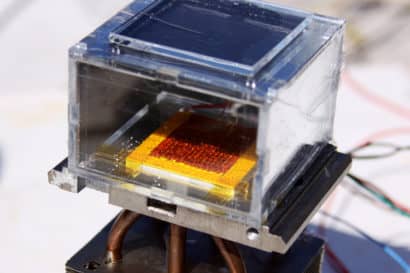According to the UN, 738 million people in the world have no access to clean drinking water. World’s fresh water supply is running short at a fast pace and scientists continue to develop ways of extracting drinkable water from seawater or even air. The Earth’s atmosphere has about 13 trillion liters of water at all times which is 10 percent of the entire freshwater supply of the planet. A team of researchers from UC Berkley and MIT has developed a method of farming moisture from the air to get drinkable water.
Systems have been invented before that condense water vapor from the air and trap it for use, but these systems usually require too much energy, if not, they need extremely humid air. The system developed by the UC Berkley and MIT researchers deals with both of these problems efficiently. The method can extract nearly 3 liters of water a day per kilogram of the absorber used.

The team studied the crystalline powders called metal organic frameworks (MOFs) that were developed for the first time by the lead researcher Omar Yaghi of UC Berkley about 20 years ago. The crystal structures are porous where the metal atoms form hubs linked together by organic compounds. The structures are flexible so the properties of the MOFs can be adjusted as per the need of the chemist to control the strength of the bonds.
MIT graduate student Hyunho Kim says, “By carefully designing this material, we can have surface properties that can absorb water very efficiently at 50 percent humidity, but with a different design, it can work at 30 percent. By selecting the right materials, we can make it suitable for different conditions. Eventually, we can harvest water from the entire spectrum” of water concentrations.
Ever since the first MOFs were developed by Yaghi, over 20,000 more have been synthesized with different structures and molecular properties. Due to the spongey nature of the crystals, they have a high surface area and become hydrophilic and attract a lot of water. When the same material is placed on a black surface to absorb solar heat keeping a lower surface at the same temperature as the air, the water cools and drops down to be collected. A sheet of MOF is placed between a solar absorber and the condenser plate inside the chamber. When the chamber is opened during the night time, the surrounding cool air flows through the MOF causing the water molecules to cool down. The chamber is closed during the day, allowing sunlight to heat it. Water molecules get heated and move towards the condenser.
The current setup easily provides enough drinking water every day for one person’s needs but to improve the output, the team continues to modify the MOF structure.
With the increase in world population, water shortage is becoming one of the biggest problems. A mechanical engineering professor at MIT, Evelyn Wang says, “There are desert areas around the world with around 20 percent humidity, but there really hasn’t been a technology available that could fill”the need. Countries like Chile and Morocco harvest fog to obtain water, but the process requires high moisture content.
The process has been realized, but we are nowhere close to the Starwars Moisture Farm. The method does look like a realistic solution to the water shortage problem in the world. We shall have to wait and see when it becomes a commercially viable solution, and the world water problems will begin to reduce.


